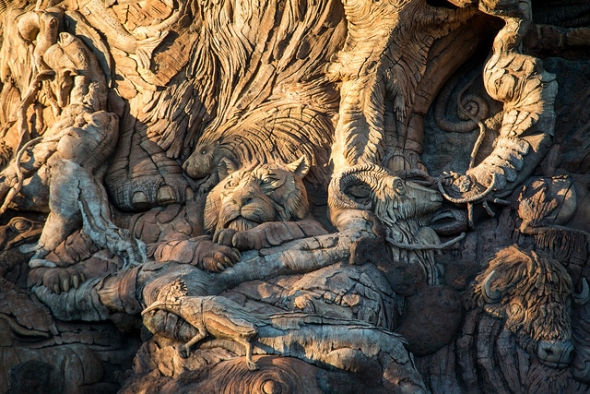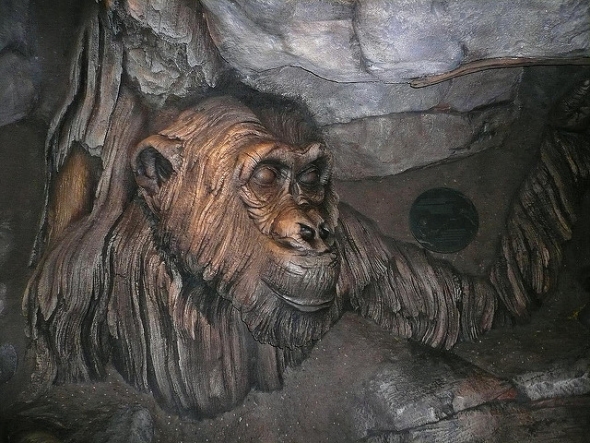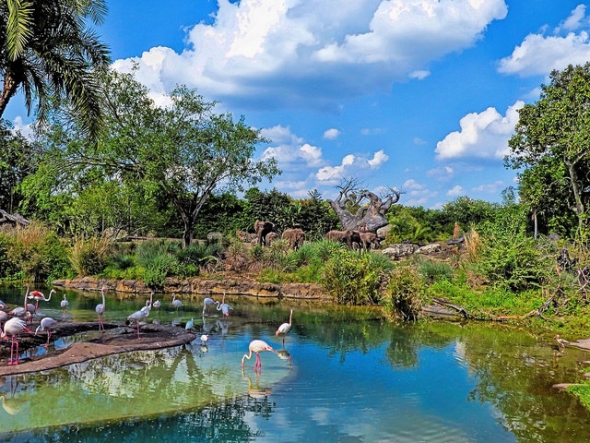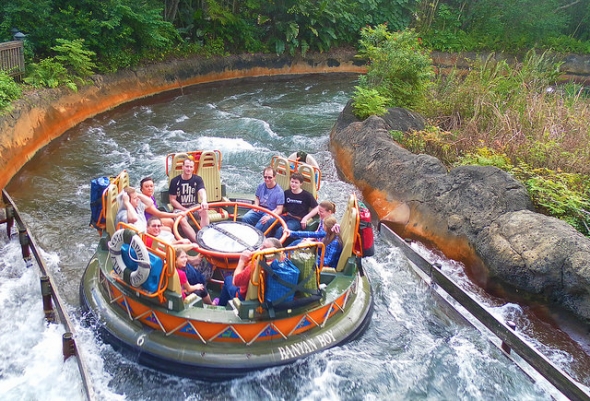Jane Goodall inspired one of the carvings on the Tree of Life.
Image: HarshLight, Flickr (license)
Unlike the Magic Kingdom, Epcot, and Disney’s Hollywood Studios, Animal Kingdom wasn’t built on a foundation of existing narratives, fairy tales, celebrated films, or historical events. Imagineers had no intention of casting wild animals in live-action reenactments of Disney’s celebrated animal-focused films; rather, as Eisner put it during the opening ceremony for the park, they wanted the animals to play a key component in an ongoing story between nature and humankind.
Equally important to Disney’s team were the legacies and contributions of those who sought to uphold the dignity and splendor of the Earth: a cast that included naturalists, zoologists, scientists, conservationists, and environmentalists, to name a few. Primatologist Jane Goodall served as a consultant for the park, and it was she who suggested an important modification to Animal Kingdom's soon-to-be iconic centerpiece.
As the story goes, the 145-foot baobab sculpture was approaching completion when Director of Animal Programs Rick Barongi decided to give Goodall a tour of the construction site. The two were admiring the intricately-carved animals on the trunk of the tree when Goodall observed that a carving of a chimpanzee had yet to be added to the 300+ animal register.
“This is wonderful, Rick, this is amazing,” said Goodall, “but there’s no chimp.” When Barongi pressed, she added, “I’ve been looking and there’s no chimp.”
Image: Michael Gray, Flickr (license)
Barongi wouldn’t rest until the situation was remedied. He brought the issue to production manager and chief sculptor Zsolt Hormay and, with it, a photograph of Goodall’s favorite chimpanzee: the silver-whiskered David Greybeard. Decades earlier, David Greybeard played a pivotal role in Goodall’s research as the first chimp to exhibit signs of trust in her and one whose behaviors of tool-making and meat consumption opened new paths and theories in primate research.
When Animal Kingdom officially opened its gates to the public, both Barongi and Hormay had a surprise for Goodall. Not only had they added Greybeard to the Tree of Life—larger than life, emerging from the roots of the tree as he peacefully ushered guests to and from the Tree of Life Theater—but they had commissioned a special plaque in her honor, which was positioned just over Greybeard’s shoulder and commemorated her groundbreaking work with primates.
Disney wanted to install another safari ride in Asia.
Image: Jennifer Lynn, Flickr (license)
Ask any Animal Kingdom aficionado to point you in the direction of the best attraction in the park, and you can bet you’ll find yourself stepping aboard the rugged outfit of a 32-passenger safari vehicle in Africa, home to pools of carousing hippopotamuses and crocodiles, savannahs teeming with long-tongued giraffes and bulky African elephants, and rocky promontories decorated with dozing lions and cheetahs.
Kilimanjaro Safaris is a spectacle that has to be experienced in order to be fully appreciated, so it’s no wonder that Imagineers once dreamed up a similar crowd-pleaser for Asia. Though the idea eventually morphed into the river rapids attraction and conservation cautionary tale Tiger Rapids Run (now Kali River Rapids), the first iteration of the ride would have taken guests on a winding boat expedition through the Himalayas, Indonesia, and India.
Image: Simon, Flickr (license)
The altered mode of transportation wasn’t the only significant difference between the Africa and Asia safari concepts. Where Kilimanjaro Safaris was focused on animal care and conservation efforts, the unrealized ‘river safari’ ride would have hewed closer to a Jungle Cruise-like layout. While onboard, guests would glimpse tigers, rhinos, tapirs, and gibbons on the banks of the river, while Asian elephants would traipse over bridges that bisected the river. The attraction also would have placed a much greater emphasis on the dangers of poaching and deforestation, concluding with a thrilling splashdown in a rapids-like area.
The ride itself, mammoth in size and scope and impractical in execution (for one thing, it would have been too difficult to keep that variety of animals safe, calm, and happy on the riverbanks all day; for another, tigers can swim), was also intended to become part of a larger narrative. The surrounding area would have included a nature walk and an immersive dining experience wrapped up in the confines of a “flooded” village… perhaps not unlike the storm-wrecked concept that proved popular for Typhoon Lagoon in 1989. In the end, however, Imagineers felt it was more practical to scrap the animal-based portions of the ride. That left them with the thrill-based Kali River Rapids, which then became the precursor to Disney California Adventure’s Grizzly River Run.





Add new comment